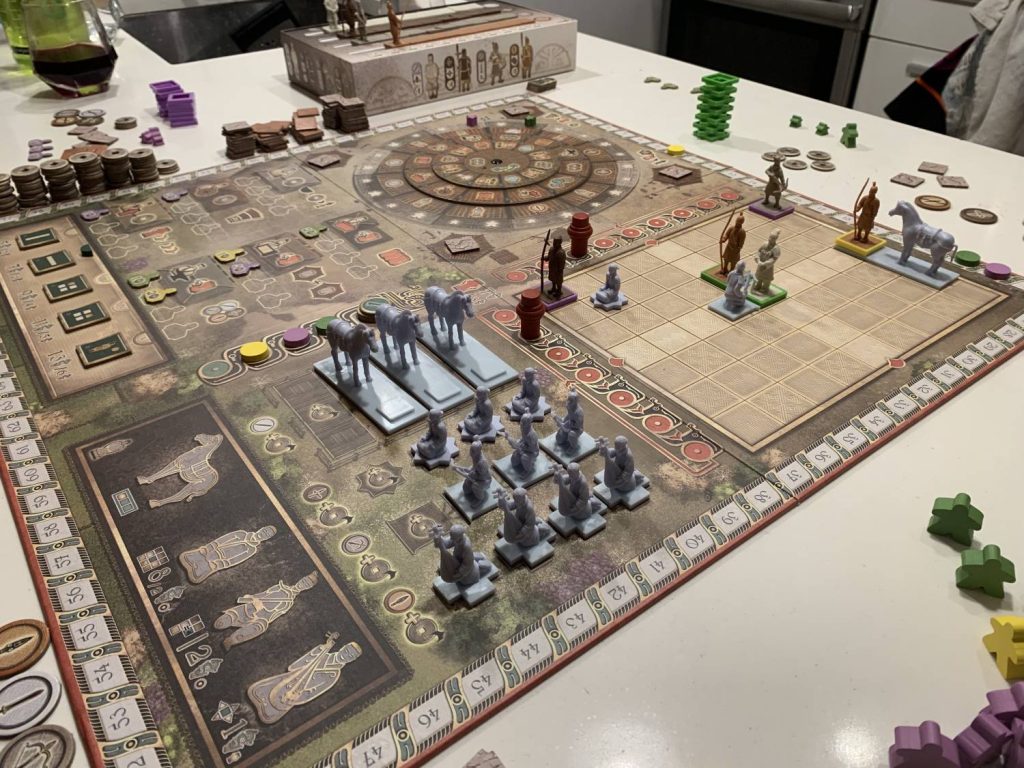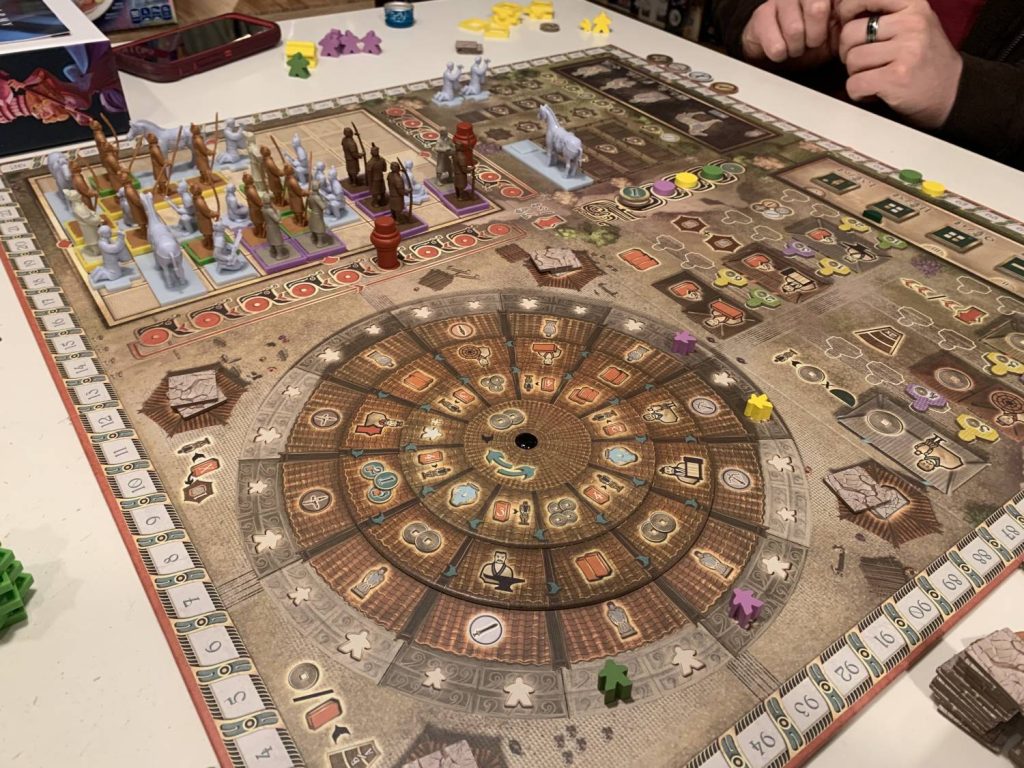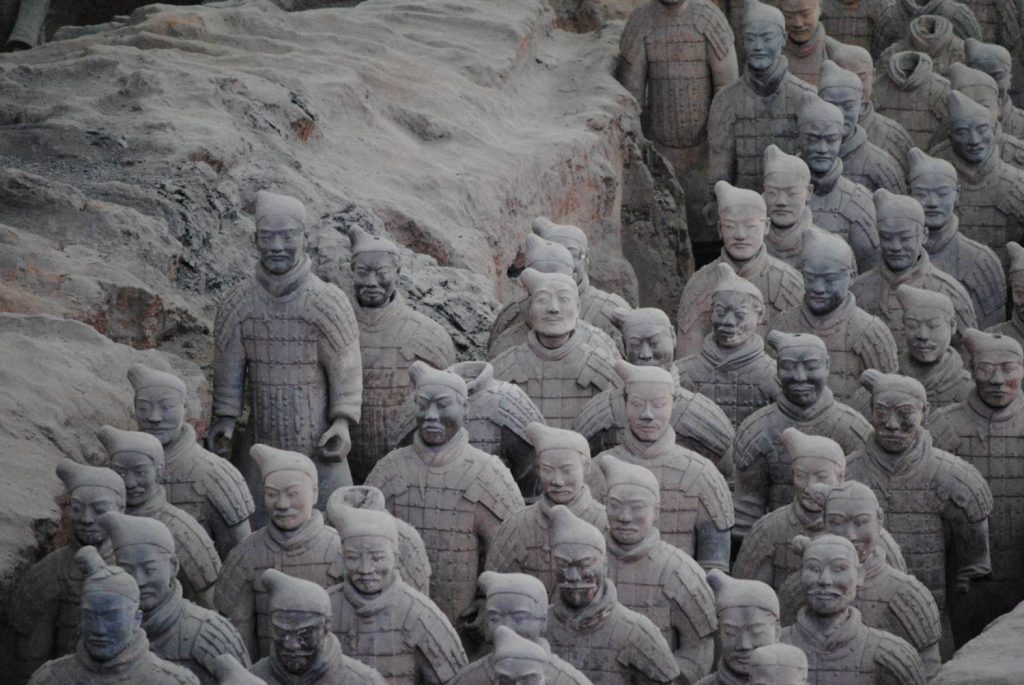Disclosure: Meeple Mountain received a free copy of this product in exchange for an honest, unbiased review. This review is not intended to be an endorsement.
The details around the Terracotta Army are, as is often the case with ancient history, a bit murky. Here’s what we know: Qin She Huang, the first emperor of China, ordered the construction of thousands upon thousands of soldiers, horses, and chariots to stand guard over his tomb at the base of Mount Li, near the city of Xi’an. The work was ordered well before he died, but given that he was subject to at least three known assassination attempts, you can’t blame the man.
Pretty much the next thing we know is that the Army was discovered by six farmers digging a well in the 1970s. The Chinese historian Sima Qian, writing some 150 years later, wrote that Emperor Qin conscripted some 700,000 workers, but that seems unlikely. It is said that the emperor’s burial chamber contained 100 flowing rivers of mercury, constellations painted on the ceiling, the full spread. Though the chamber has been located, it hasn’t been opened, so we can’t verify any of those details.
That Army, though. Hoo-boy. It is impressive. Well over 8,000 soldiers, each unique, standing in lengthy formation columns. I lived in Xi’an from 2011 to 2013, and visited the Terracotta Army on several occasions. When publisher Board & Dice announced Terracotta Army earlier this year—maybe it was last year, time is soup—I was excited for the nostalgia kick.

If It Ain’t Broke, Change It a Little Anyway
Terracotta Army is a rock-solid worker placement design. Players take turns putting a worker on one of the spaces surrounding the wheel in the upper left corner of the board. The wheel consists of three rings, which line up to create action slots. When you place your worker, you’ll perform those three actions in order from the inside to the outside.
The first thing separating this from most worker placement games is that the actions available at each space can be adjusted, albeit slightly, from turn to turn. Before placement, you can rotate either the inner or middle ring one notch in a specified direction by paying two coins. This is a cool idea, and it leads to some satisfying plays. The downside, of course, is that the quantity of options available to you and the permutations can create some painful moments of analysis paralysis, particularly early in the game when players lack a clear direction.
Your resources are money and clay, both of which will be spent on building statues in the mausoleum. I’m not a big fan of resource management, particularly when it’s the focus of a game, but Terracotta Army works for me because the resources are a means, not an end. You aren’t hoarding clay just to hoard clay, you’re hoarding it so you can build and place Warriors. You aren’t accumulating money because you want money, you’re getting money so you can play Specialists and hire Masters.

Bury Me With It
The mausoleum is simultaneously the coolest part of this game and impenetrable enough to possibly constitute a flaw. If you like to have a firm handle on who’s winning as you play, the mausoleum is probably a deal-breaker. There’s a lot going on in there, so much so that the fineries of scoring are not worth going into here. Just know that it’s a shifting and overlapping series of area majority contests.
There are two types of statues, Warriors and Specialists. The Warriors, placement depending, can score you points during the inter-round scoring phases and at the end of the game. Each of the four Warrior types has an ability that can be activated upon placement, provided you have the corresponding Weapon Token.
The Specialists do not score any points themselves, but they create or modify scoring conditions. The Kneeling Archer acts as a tie-breaker in favor of the statue it’s facing. The Footman awards eight points at the end of the game to the player most represented in the eight spaces surrounding it. The Musician gives one point per Warrior to any player with pieces in the same row and column.
Play in the Mausoleum is further affected by the five randomized scoring tiles, one for each round, which will often encourage construction of statues in specific sections. The feel of the mausoleum changes every game, as players get more experienced and take different approaches.
That’s a general strength of Terracotta Army. It absolutely allows for a variety of approaches, and they’re all valid so long as you execute them well. I’ve seen players rush building statues early, which earns more short term points, while others have waited for wise end-game placements to make themselves more readily apparent. I’ve seen players go for clay at every opportunity, and others content themselves to make the most of a minimal supply.

Putting the Pro in Production
Where I grow outright effusive about this design is in its production. This is a masterclass in how to design a game so it is as approachable as possible. The board includes unobtrusive, text-free reminders of everything you need. Nothing is ambiguous. Despite everything going on here, player questions evaporate entirely by the end of the second round. The Warrior statues come in a box that includes icons on each of its four sides explaining what each Warrior class does when its ability is activated. The Specialist miniatures are designed with bases that work perfectly to remind you what each of them does. It’s truly thoughtful work, and I applaud everyone involved.

I haven’t even mentioned the manual yet. Terracotta Army might have the best manual I’ve ever read, and I read a lot of them. I read the instructions in a loud environment under time pressure and had to immediately play some other games for work. These are not ideal circumstances for rule retention with even the simplest of games, let alone one this complicated. When I came back to the people who were playing it some two and a half hours later—don’t worry, it was only that long because none of them had already read the rules—I knew exactly what was going on, how everything worked, and had retained all of the rules.
The manual is written in a way that is pleasant to read. I don’t feel like I’m reading a policy journal. When returning to the game after a couple of weeks, I read certain parts out loud to the new players joining me, and their eyes didn’t glaze over. It is sensibly organized, moving through the game in an order that makes sense to the learner. It includes illustrations that address just about any question you might have. Four or five times, I found myself reading a rule and thinking “But what about–,“ only to have my question immediately answered by an illustration to the right or left.
I don’t know why every manual isn’t this good. This is it. This is the one we’ve been waiting for. Rulebook writers the world over should read this manual to see how it’s done. Shoot, go to your local and pay $50 or $60 to read the manual. That you happen to get a really good game with it is a nice bonus.
I’ve discovered in the course of writing this review that I’m even more positive about Terracotta Army than I expected. I don’t have any particularly strong feelings about it, I don’t think, despite the extent to which I appreciate it. I’m more likely to say positive things when it comes up than I am to bring it up myself, if that makes sense.
I would strongly recommend the game if you don’t love resource management or worker placement, but you have a gaming group that does. Terracotta Army scratches those itches for people who suffer from them, and you will have a good time too. If you are invested in worker placement as a genre, you should find a lot to love here. It’s familiar enough to be readily approachable, and brings enough that’s new to provide for a novel experience. Ain’t nothing wrong with that. 好了。













Add Comment